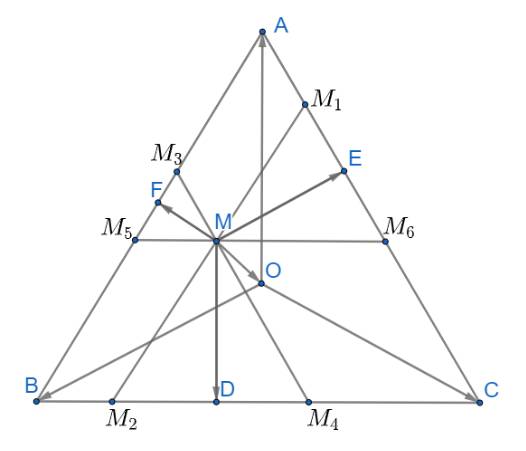Hãy nhập câu hỏi của bạn vào đây, nếu là tài khoản VIP, bạn sẽ được ưu tiên trả lời.

Ta có \(\overrightarrow{AE}=\overrightarrow{AM}+\overrightarrow{ME}\)
\(=\frac{1}{2}\overrightarrow{AB}+\frac{1}{3}\overrightarrow{MN}\)
\(=\frac{1}{2}\overrightarrow{AB}+\frac{1}{6}\overrightarrow{BC}\)
\(=\frac{1}{2}\left(\overrightarrow{AB}+\frac{1}{3}\overrightarrow{BC}\right)\)
\(=\frac{1}{2}\left(\overrightarrow{AB}+\overrightarrow{BF}\right)=\frac{1}{2}\overrightarrow{AF}\)
\(\Rightarrow A;E;F\) thẳng hàng

minh dang nghi cau a con cau b minh ra r ban co can k
b)me=1/3mn bf=1/3bcmn//bc
=>me//bf
=>e la trung diem cua af
=> AEF thang hang

Bạn xem lại đề ạ!
Nếu bạn đã chứng minh được D là trung điểm IQ; E là trung điểm KP; E là trung điểm KP; F là trung điểm LJ
Thì dễ dàng suy ra được: \(\overrightarrow{MD}=\frac{\overrightarrow{MI}+\overrightarrow{MQ}}{2}\); \(\overrightarrow{ME}=\frac{\overrightarrow{MK}+\overrightarrow{MP}}{2}\); \(\overrightarrow{MF}=\frac{\overrightarrow{MJ}+\overrightarrow{ML}}{2}\)
( Vì chúng ta có tính chất: Nếu I là trung điểm đoạn thẳng AB thì mọi điểm M ta có: \(2\overrightarrow{MI}=\overrightarrow{MA}+\overrightarrow{MB}\))

\(\overrightarrow {MD} + \overrightarrow {ME} + \overrightarrow {MF} = \left( {\overrightarrow {MO} + \overrightarrow {OD} } \right) + \left( {\overrightarrow {MO} + \overrightarrow {OE} } \right) + \left( {\overrightarrow {MO} + \overrightarrow {OF} } \right)\)
Qua M kẻ các đường thẳng \({M_1}{M_2}//AB;{M_3}{M_4}//AC;{M_5}{M_6}//BC\)
Từ đó ta có: \(\widehat {M{M_1}{M_6}} = \widehat {M{M_6}{M_1}} = \widehat {M{M_4}{M_2}} = \widehat {M{M_2}{M_4}} = \widehat {M{M_3}{M_5}} = \widehat {M{M_5}{M_3}} = 60^\circ \)
Suy ra các tam giác \(\Delta M{M_3}{M_5},\Delta M{M_1}{M_6},\Delta M{M_2}{M_4}\) đều
Áp dụng tính chất trung tuyến \(\overrightarrow {AM} = \frac{1}{2}\left( {\overrightarrow {AB} + \overrightarrow {AC} } \right)\)(với M là trung điểm của BC) ta có:
\(\overrightarrow {ME} = \frac{1}{2}\left( {\overrightarrow {M{M_1}} + \overrightarrow {M{M_6}} } \right);\overrightarrow {MD} = \frac{1}{2}\left( {\overrightarrow {M{M_2}} + \overrightarrow {M{M_4}} } \right);\overrightarrow {MF} = \frac{1}{2}\left( {\overrightarrow {M{M_3}} + \overrightarrow {M{M_5}} } \right)\)
\( \Rightarrow \overrightarrow {MD} + \overrightarrow {ME} + \overrightarrow {MF} = \frac{1}{2}\left( {\overrightarrow {M{M_2}} + \overrightarrow {M{M_4}} } \right) + \frac{1}{2}\left( {\overrightarrow {M{M_1}} + \overrightarrow {M{M_6}} } \right) + \frac{1}{2}\left( {\overrightarrow {M{M_3}} + \overrightarrow {M{M_5}} } \right)\)
Ta có: các tứ giác \(A{M_3}M{M_1};C{M_4}M{M_6};B{M_2}M{M_5}\) là hình bình hành
Áp dụng quy tắc hình bình hành ta có
\(\overrightarrow {MD} + \overrightarrow {ME} + \overrightarrow {MF} = \frac{1}{2}\left( {\overrightarrow {M{M_2}} + \overrightarrow {M{M_4}} } \right) + \frac{1}{2}\left( {\overrightarrow {M{M_1}} + \overrightarrow {M{M_6}} } \right) + \frac{1}{2}\left( {\overrightarrow {M{M_3}} + \overrightarrow {M{M_5}} } \right)\)
\( = \frac{1}{2}\left( {\overrightarrow {M{M_1}} + \overrightarrow {M{M_3}} } \right) + \frac{1}{2}\left( {\overrightarrow {M{M_2}} + \overrightarrow {M{M_5}} } \right) + \frac{1}{2}\left( {\overrightarrow {M{M_4}} + \overrightarrow {M{M_6}} } \right)\)
\( = \frac{1}{2}\overrightarrow {MA} + \frac{1}{2}\overrightarrow {MB} + \frac{1}{2}\overrightarrow {MC} = \frac{1}{2}\left( {\overrightarrow {MA} + \overrightarrow {MB} + \overrightarrow {MC} } \right)\)
\( = \frac{1}{2}\left( {\left( {\overrightarrow {MO} + \overrightarrow {OA} } \right) + \left( {\overrightarrow {MO} + \overrightarrow {OB} } \right) + \left( {\overrightarrow {MO} + \overrightarrow {OC} } \right)} \right)\)
\( = \frac{1}{2}\left( {3\overrightarrow {MO} + \left( {\overrightarrow {MA} + \overrightarrow {MB} + \overrightarrow {MC} } \right)} \right) = \frac{3}{2}\overrightarrow {MO} \) (đpcm)
Vậy \(\overrightarrow {MD} + \overrightarrow {ME} + \overrightarrow {MF} = \frac{3}{2}\overrightarrow {MO} \)


Lời giải:
a) Vì $M$ là trung điểm của $EF$ nên \(\overrightarrow {ME}+\overrightarrow{MF}=0\), tương tự \(\overrightarrow{NB}+\overrightarrow{NC}=0\)
Từ đkđb ta cũng có \(AE=\frac{1}{3}AB;AF=\frac{3}{5}AC\)
Ý 1:
\(\left\{\begin{matrix} \overrightarrow{AM}=\overrightarrow{AE}+\overrightarrow{EM}\\ \overrightarrow{AM}=\overrightarrow{AF}+\overrightarrow{FM}\end{matrix}\right. \)
\(\Rightarrow 2\overrightarrow{AM}=\overrightarrow{AE}+\overrightarrow{AF}-(\overrightarrow{ME}+\overrightarrow{MF})=\overrightarrow{AE}+\overrightarrow{AF}\)
\(=\frac{1}{3}\overrightarrow{AB}+\frac{3}{5}\overrightarrow{AC}\)\(\Leftrightarrow \overrightarrow{AM}=\frac{1}{6}\overrightarrow{AB}+\frac{3}{10}\overrightarrow{AC}\)
Ý 2:
\(\left\{\begin{matrix} \overrightarrow{MN}=\overrightarrow{ME}+\overrightarrow{EB}+\overrightarrow{BN}\\ \overrightarrow{MN}=\overrightarrow{MF}+\overrightarrow{FC}+\overrightarrow{CN}\end{matrix}\right.\Rightarrow 2\overrightarrow{MN}=(\overrightarrow{ME}+\overrightarrow{MF})+\overrightarrow{EB}+\overrightarrow{FC}-(\overrightarrow{NB}+\overrightarrow{NC})\)
\(\Leftrightarrow 2\overrightarrow{MN}=\overrightarrow{EB}+\overrightarrow{FC}=\frac{2}{3}\overrightarrow{AB}+\frac{2}{5}\overrightarrow{AC}\)
\(\Leftrightarrow \overrightarrow{MN}=\frac{1}{3}\overrightarrow{AB}+\frac{1}{5}\overrightarrow{AC}\)
b)
Theo đkđb ta có: \(\overrightarrow{BG}=3\overrightarrow{CG}\)
\(\left\{\begin{matrix} \overrightarrow{AG}=\overrightarrow{AB}+\overrightarrow{BG}\\ \overrightarrow{AG}=\overrightarrow{AC}+\overrightarrow{CG}\end{matrix}\right.\Leftrightarrow \left\{\begin{matrix} \overrightarrow{AG}=\overrightarrow{AB}+\overrightarrow{BG}\\ 3\overrightarrow{AG}=3\overrightarrow{AC}+3\overrightarrow{CG}\end{matrix}\right.\)
\(\Rightarrow 2\overrightarrow{AG}=3\overrightarrow{AC}-\overrightarrow{AB}\Rightarrow \overrightarrow{AG}=\frac{3}{2}\overrightarrow{AC}-\frac{1}{2}\overrightarrow{AB}\)
Lại có:
\(\overrightarrow{EG}=\overrightarrow{EA}+\overrightarrow{AG}=\frac{-1}{3}\overrightarrow{AB}+\frac{3}{2}\overrightarrow{AC}-\frac{1}{2}\overrightarrow{AB}=\frac{3}{2}\overrightarrow{AC}-\frac{5}{6}\overrightarrow{AB}\)
\(\overrightarrow{FG}=\overrightarrow{FA}+\overrightarrow{AG}=\frac{-3}{5}\overrightarrow{AC}+\frac{3}{2}\overrightarrow{AC}-\frac{1}{2}\overrightarrow{AB}=\frac{9}{10}\overrightarrow{AC}-\frac{1}{2}\overrightarrow{AB}\)
c) Từ phần b ta thấy \(\frac{3}{5}\overrightarrow{EG}=\overrightarrow{FG}\Rightarrow E,G,F\) thẳng hàng.

A B C D O M N E F
a) Giả sử \(\overrightarrow{OA}+\overrightarrow{OC}=\overrightarrow{OB}+\overrightarrow{OD}\)
\(\Leftrightarrow\overrightarrow{OA}+\overrightarrow{OC}-\overrightarrow{OB}-\overrightarrow{OD}=\overrightarrow{0}\)
\(\Leftrightarrow\overrightarrow{OA}+\overrightarrow{BO}+\overrightarrow{OC}+\overrightarrow{DO}=\overrightarrow{0}\)
\(\Leftrightarrow\left(\overrightarrow{BO}+\overrightarrow{OA}\right)+\left(\overrightarrow{DO}+\overrightarrow{OC}\right)=\overrightarrow{0}\)
\(\Leftrightarrow\overrightarrow{BA}+\overrightarrow{DC}=\overrightarrow{0}\) (đúng do tứ giác ABCD là hình bình hành).
b) \(\overrightarrow{ME}+\overrightarrow{FN}=\overrightarrow{MA}+\overrightarrow{AE}+\overrightarrow{FC}+\overrightarrow{CN}\)
\(=\left(\overrightarrow{MA}+\overrightarrow{CN}\right)+\left(\overrightarrow{AE}+\overrightarrow{FC}\right)\).
Do các tứ giác AMOE, MOFB, OFCN, EOND cũng là các hình bình hành.
Vì vậy \(\overrightarrow{CN}=\overrightarrow{FO}=\overrightarrow{BM};\overrightarrow{FC}=\overrightarrow{ON}=\overrightarrow{ED}\).
Do đó: \(\overrightarrow{ME}+\overrightarrow{FN}=\left(\overrightarrow{MA}+\overrightarrow{CN}\right)+\left(\overrightarrow{AE}+\overrightarrow{FC}\right)\)
\(=\left(\overrightarrow{MA}+\overrightarrow{BM}\right)+\left(\overrightarrow{AE}+\overrightarrow{ED}\right)\)
\(=\overrightarrow{BA}+\overrightarrow{AD}=\overrightarrow{BD}\) (Đpcm).